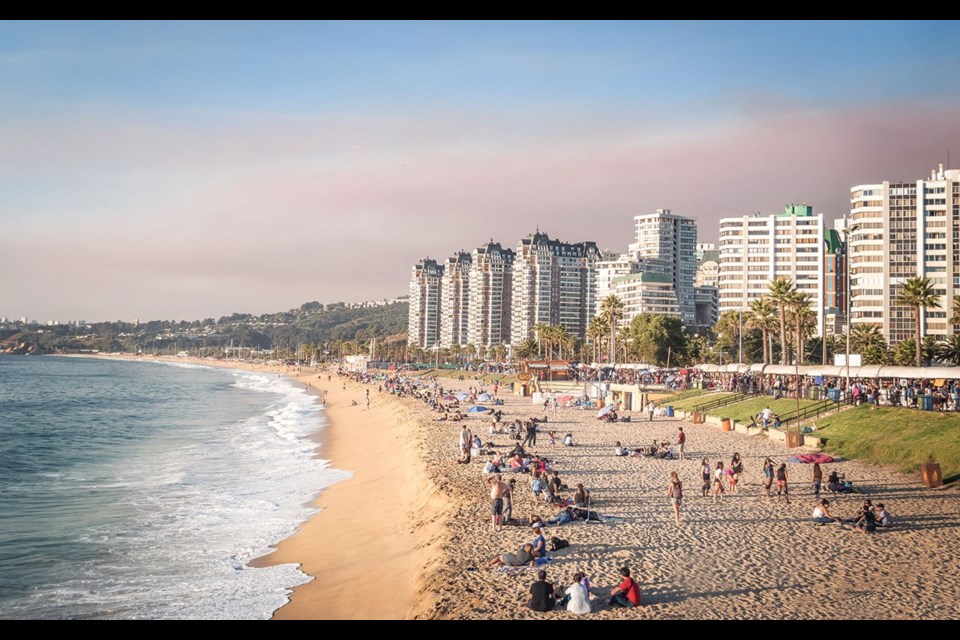At first glance, Viña del Mar is a lot like Vancouver's West End: freighters sit in the bay, which is lined with a public beach while modern, glass, apartment buildings stretch to the sky against a backdrop of mountains.
But then a stray dog wanders by and plops down in the middle of the busy sidewalk beside several other snoozing dogs. People saunter around the dogs, taking time to pet or feed them. And, though it's almost 8 p.m., restaurants aren't yet open for the evening meal.
This charming Chilean city by the sea feels different: more laissez faire and less rain-city bustle. Of course, with a population half the size of Vancouver's, far more sunshine and less precipitation, that's not surprising.
The modern ambiance is due to the fact that only a few buildings from the 19th century remain after multiple earthquakes destroyed many old areas. Since then, pretty palaces and even a castle have been built, set amidst lush gardens laced with palm trees. This, plus expansive parks, boulevards lined with flowers and a giant floral clock have earned Viña the nickname of Garden City.
Since it's only 130 kilometres west of Santiago, many North Americans only do a day trip to Viña. But we follow the lead of Santiaguinos, who come to vacay, to chill here for several days.
(Of course, we took a much longer route to get here—an eight-hour bus ride over the Andes from Argentina through Paso de los Libertadores, reaching an elevation of 3,200 metres. It's billed as one of the most scenic drives in the world and, near the Chilean border, provides magnificent views of South America's highest peak, Aconcagua, and the gnarly switchbacks down. It's a fantastic way to see the mountains up close and personal but I was very glad not to be doing the driving!)
We stay at the Sheraton because of its superb location: perched on a cliff, its rooms offer 180-degree views from balconies jutting over the ocean. There is a gym with the same view—never have I felt so inspired to work out!
Our days take on a pleasing no-stress pattern: a mid-morning run along the promenade (when you finish dinner at midnight, rising early isn't in the cards), brunch on the patio (make sure to ask for café, café to avoid getting Nescafe), a day trip—to Valparaiso or Casablanca Valley, a relatively new wine area fast becoming known for its sauvignon blancs and chardonnays—a nap (hey, we're on holiday) and a late supper.
Today, we stay in town to visit the quirky Fonck Museum, which boasts a large moai near the entrance—the only Easter Island statue on the mainland. (Chile annexed the island in 1888.) A small wing is dedicated to the history of Easter Island; a series of rooms detail the history and geology of Chile. Things get a bit weird upstairs. One room is filled with random toys—spinning tops, tin horses—and others are stuffed with preserved Chilean pumas, and penguins and case upon case of beetles and butterflies from all over the world.
Nearby is the posh FABA jewelry store, showcasing Chile's nation gemstone, Lapis Lazuli. But we spend our pesos at the local handicrafts market on the promenade, where the blue stone is set in silver and sold—especially after bartering—for a fair price.
Indeed, the promenade is the highlight of Vina, providing entertaining people, dog and bird watching. Surfers glide along the waves; artists concoct sculptures out of sand; there is a life-size chess table where knights and kings are touched up with fresh paint by day to ready for matches played at night; hundreds of pelicans drift and soar overhead and then dive head first for fish. Dogs dash along the sand, gratefully accepting handouts.
Back in our room, we soak in a blood-orange sunset from our balcony as we slowly sip some Chilean chardonnay. We find that if we attempt to dine before 10, we are the only ones in the restaurant.
We've had wonderful luck with restos here, feasting on oh-so-fresh razor clams and loco (a meaty, thick abalone), scallops and barnacles.
Tonight, we head to La Ciboulette, a tiny place (only six tables) run by a Belgian for a unique riff on Chilean French-Belgian cuisine. The owner is a bit gruff as he hauls the menu board from the door to our table but warms up as the evening progresses. My limited French comes in handy, though the chef yells out in English from the kitchen to help us decipher the menu.
As has become our habit, we start with a pisco sour—considered the national drink of Chile, though Peruvians claim they invented it—made of grape brandy, fresh-squeezed lemon juice, sugar, and a frothy egg white topping. Then one of us goes the French route and the other sticks with seafood: French onion soup and bœuf bourguignon; salmon Carpaccio and yellow tail tuna. We share a bottle of Carménère and the owner, who seems to have taken a shine to us, gives my husband a complimentary glass of cab sauv. (We get a discount for paying cash.)
It's not yet midnight when we are back on the Promenade, so we consider our options: a visit to the 1930s-era art deco casino or a nightclub.
But we are feeling too Zen for that. Instead, we amble along under the spectacular southern sky. According to the Smithsonian, Chile may be the best place on earth to enjoy a starry sky.
And we say star gazing is good for our souls.
For Part 1 of Virginia's trip to Chile, go to www.piquenewsmagazine.com Jan. 24, 2019.




